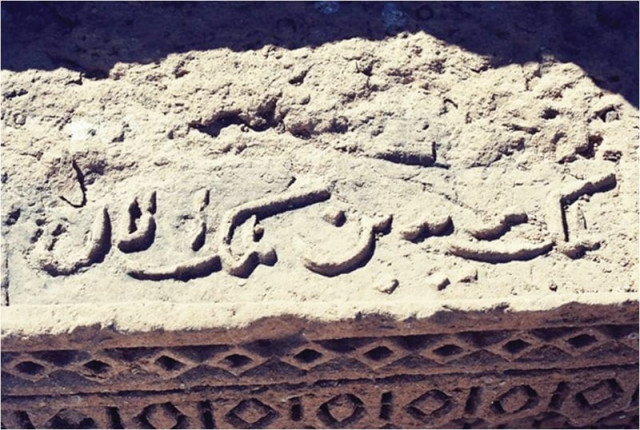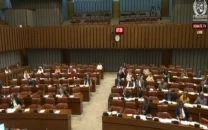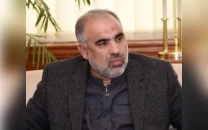Karachi Conference: Going back in time to Karachi...Kurrachee...Kaurashi...Ras alKarazi
First session of Second Karachi Conference covers the Burfat tribe, rock art and the forgotten Victoria Museum.

Karachi Conference: Going back in time to Karachi...Kurrachee...Kaurashi...Ras alKarazi
The Second Karachi Conference wanted to dig deep into the city's roots. With 17th century references to the historical tribe of Burfat, the pre-historic rock art in Gadap Town and the imperial antiques from Victoria Museum, the first session manages to do just that.
The first day of the conference, which is taking place as part of the city-wide peace campaign 'I Am Karachi', took place on Friday with an audience that comprised mostly speakers from sessions later in the day and a few students. Historian Dr Nomanul Haq, who teaches at IBA, chaired the first session with a frank admission that "he had to meet" Dr Asma Ibrahim, also part of the panel.

The physical presence of the Burfat tribe of Sindh can be seen in inscriptions, such as the one above. (Right) The rock art of Maher Valley was mostly in black and orange due to the influence of Hindu deities. PHOTOS: COURTESY DR KALEEMULLAH LASHARI AND DR ZULFIQAR ALI KALHORO
Dr Haq introduced the remaining panellists - Dr Kaleemullah Lashari and Dr Zulfiqar Ali Kalhoro - with a customary request to stick to the time; something that forced Dr Lashari to skip several of his slides.
Burfat migration
Migration, it appears, is a trend that is not new to Karachi and the Burfat tribe of Kirthar Range made the move as early as the 17th century. The background of the Burfats, also known as the Nuhmardee Baloch, is more of a myth than historical fact, admitted Dr Lashari, adding how the tribe has been associated with the Arabs, the Rajputs and the Baloch.
"Their names and activities are celebrated in folklore," he said. The most logical explanation comes, however, from Meerak Yousuf, who says the tribe was one of the nine factions of Samejahs that broke away and went to live in the highlands, he added.
It was during the time of the Mughals that the Burfats were compelled to be a part of the mainstream and forced to inhabit areas closer to Karachi, said Dr Lashari. Later, they gained more economic power. "The Burfats were employed as guards to escort merchandise being transported from the ports of Karachi and Sonmiani," he said, adding that their physical presence in the city can be seen in Manghopir and the tombs of Chawkandi. "Their unity is overbearing," he said, referring to the current third-generation Burfats who are very much a part of society, with representation in the National Assembly. "They still keep together."
Dr Lashari also spoke about the references to Karachi that have been made through time and listed some of the names this area has been given, such as Karachi, Kurrachee, Crochey, Kaurashi, Ras Karashi, Ras alKarazi and alKarazi.
Rock paintings
Dr Kalhoro, an assistant professor at Pakistan Institute of Development Economics, took the audience further back in his presentation on rock art. The city is home to rock paintings that date as far back as the Mesolithic and Historic periods, and the Bronze Age.
There are nearly 16 to 20 sites in the city where rock paintings have been found, he pointed out, adding that most of these sites are part of Gadap Town.
The Maher Valley, located some 70km to the north of the city, houses a large number of rock shelters where various paintings have been found. "Most of the rock art in Maher Valley is found in black and orange colour," he said, associating it with Hindu deities.
Remembering Victoria Museum
Dr Asma Ibrahim was so passionate about the state of museums in the city that her voice reached a certain pitch when she spoke. Her research may still be in its early stages but Dr Ibrahim has collected enough data to know that Sindh's history is on the brink of collapse, quite literally. The papers archived at the National Museum are one-touch away from dissolving completely, she said.
When she became associated with the National Museum, Dr Ibrahim found several abandoned cartons lying in the storeroom. These termite-infested boxes carried "a treasure of antiquities" that, most likely, belonged to Victoria Museum, which now houses the Supreme Court Karachi registry.
According to Dr Ibrahim, several of these items have been preserved but a large number of them are missing, such as the gold coins that were donated by the provincial government in 1930-31.
"After 150 years, we again feel there should be a Karachi Museum," she said. "Even some judges [of the Supreme Court] have expressed their willingness to vacate the building to restore Victoria Museum."
Published in The Express Tribune, November 22nd, 2014.


1735037907-0/Tribune-N-(2)1735037907-0-208x130.webp)
















COMMENTS
Comments are moderated and generally will be posted if they are on-topic and not abusive.
For more information, please see our Comments FAQ